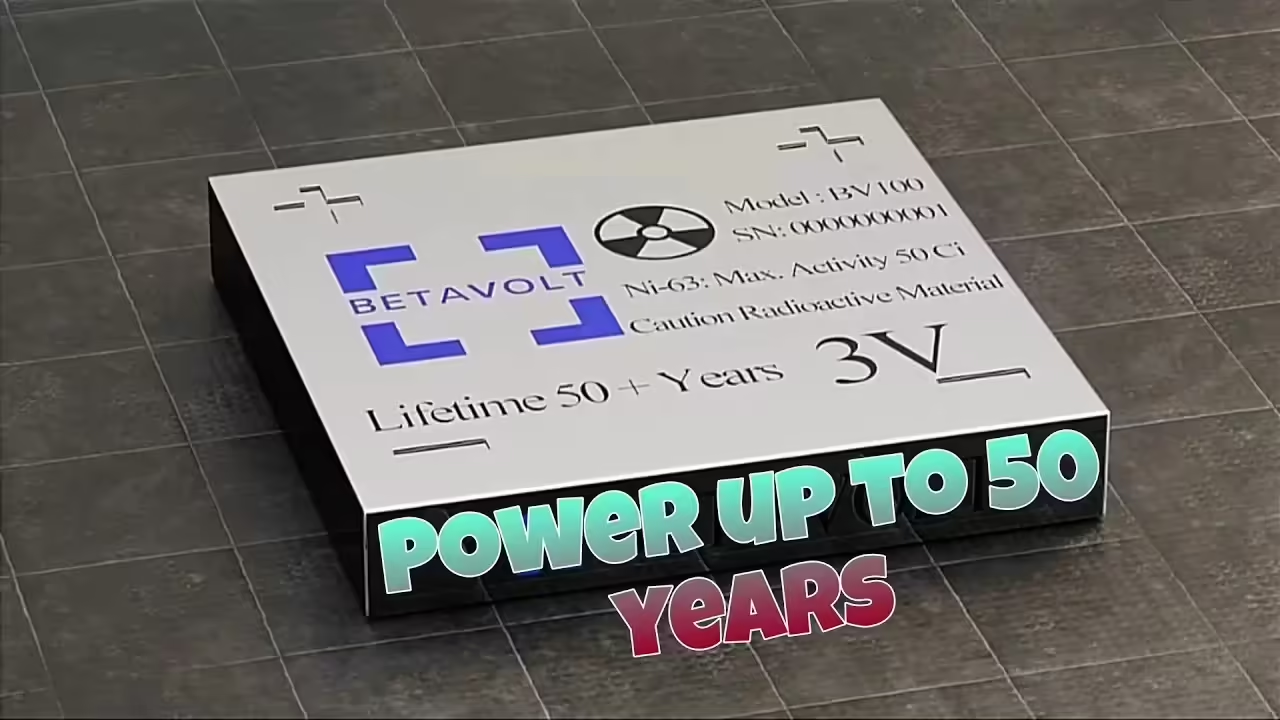
The search for alternative and sustainable energy sources is one of the great challenges of humanity in the 21st century. A Chinese company, Betavolt, has announced that it is developing a radioactive battery that could power a mobile phone for half a century without the need for recharging.
According to the company, this battery uses tritium, a radioactive isotope of hydrogen, as fuel. Tritium combines with a layer of silicon to generate electricity through a process called betavoltaic. The advantage of this system is that tritium has a half-life of 12.3 years, meaning it decays very slowly and releases a constant amount of energy.
Betavolt claims that its radioactive battery is environmentally and human health-friendly, as the radiation emitted by tritium is very weak and cannot penetrate the battery casing or human skin. Moreover, the company asserts that its product generates no nuclear waste or carbon emissions.
The company plans to launch its first radioactive battery in 2025, with a size similar to that of an AA battery and a capacity of 3,000 milliampere-hours (mAh). This battery could be used to power low-consumption electronic devices such as sensors, watches, or medical implants. Betavolt also plans to create larger and more powerful batteries in the future for charging mobile phones, laptops, or even electric cars.
Exploring the Revolutionary Radioactive Battery Presented by China
The constant evolution of technology has been the driving force behind human progress throughout history. In this journey toward the future, China has emerged as an undisputed leader in technological innovation. One of China’s most recent and fascinating contributions to the world of technology is the radioactive battery, a revolutionary energy source that promises to transform how we power our electronic devices and vehicles.
The Energy Challenge and the Search for Sustainable Solutions
In an increasingly technology-dependent world, the demand for sustainable and efficient energy sources is more pressing than ever. Conventional batteries, while advancing in terms of capacity and lifespan, still face challenges related to lifespan, charging speed, and material availability. The search for more efficient and environmentally friendly solutions has led to the research and development of innovative technologies, and the radioactive battery emerges as a promising option.
The Radioactive Battery: A Revolutionary Approach
The radioactive battery, developed by Chinese scientists, is based on radioisotope thermoelectric conversion technology. This technology uses radioactive materials to generate controlled heat, which is then directly converted into electricity through thermoelectric devices. The key to this approach lies in the safe and efficient use of radioactive isotopes, minimizing the risks associated with radiation.
Potential Advantages of the Radioactive Battery
This innovative technology presents various advantages that could change the energy landscape. Firstly, the radioactive battery has the ability to generate electricity continuously for long periods, without relying on external sources such as sunlight or wind. This makes it an ideal option for powering critical devices and systems that require a constant energy supply.
Moreover, the lifespan of these batteries could significantly surpass conventional batteries, reducing the need for frequent replacements and contributing to long-term sustainability. The technology also has the potential for use in space applications, where the availability of reliable energy sources is crucial.
Challenges and Ethical Considerations
Despite its promising features, the implementation of the radioactive battery is not without challenges and ethical considerations. Safe management of radioactive materials and proper waste disposal are critical aspects that must be addressed to ensure the long-term safety and sustainability of this technology. Additionally, establishing strict regulations is essential to prevent misuse and ensure that the technology is used exclusively for peaceful and beneficial purposes.
Betavolt: Pioneers in Energy Technology
At the heart of the current energy revolution is Betavolt, a Chinese company that is changing the game with its innovative radioactive battery. As a prominent leader in energy technology, Betavolt has captured the world’s attention with its revolutionary approach to addressing challenges in energy supply and storage. In this article, we will delve into Betavolt’s vision and ambitious goals, as well as the potential impact of its advanced technology.
The Genesis of Betavolt: From Vision to Reality
Founded in [foundation year], Betavolt has evolved from its humble beginnings to become a reference in the field of energy technology. The company was conceived with the bold vision of addressing the limitations of conventional energy sources and exploring innovative solutions to ensure a sustainable and efficient supply.
Betavolt’s team of scientists and engineers has tirelessly worked to develop the radioactive battery, a technology that uses radioisotopes safely and efficiently to generate continuous electricity. This achievement not only highlights the technical excellence of the company but also its commitment to sustainability and the pursuit of solutions that drive progress.
Ambitious Goals: Beyond the Radioactive Battery
Although the radioactive battery is Betavolt’s flagship, the company does not settle for limiting itself to a single innovation. Its vision encompasses a broad spectrum of advanced energy technologies, with the goal of diversifying and optimizing energy sources to meet the growing demands of the modern world.
Betavolt is investing significantly in the research and development of emerging technologies, such as molecular-level energy storage, artificial intelligence applied to electrical grid management, and ultra-fast charging systems. These ambitious goals reflect the company’s determination to lead the forefront of technological innovation and provide comprehensive solutions for current and future energy challenges.
Commitment to Safety and Sustainability
One key concern associated with radioactive technology is safety. Betavolt addresses this challenge head-on by implementing rigorous safety protocols at all stages of production, from handling isotopes to battery manufacturing. Moreover, the company is committed to the responsible management of radioactive waste and collaborates closely with regulatory authorities to ensure compliance with the highest standards.
In terms of sustainability, Betavolt recognizes the importance of minimizing its environmental footprint. The extended lifespan of radioactive batteries and improved efficiency contribute to the global reduction of electronic waste and encourage more sustainable practices in energy consumption.
Unprecedented Charging Capacity: Analyzing the Astonishing 50-Year Battery for Mobile Devices
In a technological breakthrough that could revolutionize how we interact with our mobile devices, a new generation of batteries has emerged with an unprecedented charging capacity: the ability to power mobile devices for 50 years without recharging. This technical achievement, promising to end the constant worry about battery life, is generating excitement and anticipation in the technology world. In this article, we will explore the science behind this remarkable capacity and the potential implications for everyday life.
Innovative Technology behind the 50-Year Battery
The 50-year battery is based on a combination of advances in nanotechnology and new materials. The key to its longevity lies in the ability to retain and release energy extremely efficiently over time. The materials used in the construction of these batteries have been designed to withstand charge and discharge cycles on a much larger scale than conventional batteries, providing an unprecedented lifespan.
Additionally, nanotechnology plays a crucial role by enabling molecular-scale structures that optimize storage capacity and energy efficiency. These combined innovations have resulted in a battery that not only charges mobile devices for 50 years but also does so more quickly and efficiently than current batteries.
Implications for Everyday Life and Mobile Technology
The 50-year charging capacity has the potential to completely transform how we use our mobile devices. Battery-related anxiety, a common experience for many users, could become a thing of the past. Smartphones, tablets, and other mobile devices could operate seamlessly for decades, eliminating the need for constant charging and providing a smoother user experience.
Moreover, this innovation could have a significant impact on implantable medical devices and assistive technologies, where battery life is critical. Users of these devices could greatly benefit from an extended lifespan, reducing the frequency of medical interventions related to battery replacement.
Global Perspectives on Chinese Innovation: The Presentation of the Radioactive Battery in the Global Technological and Energy Landscape
China has emerged as a dominant force in the field of technological and energy innovation, and its recent presentation of the radioactive battery has captured global attention. In this context, it is essential to contextualize this innovation within the broader landscape of global technological and energy innovation, examining the implications, challenges, and opportunities it presents.
Rise of China as an Innovative Power
The past decade has witnessed China’s meteoric rise as a leading power in innovation. The Asian nation has significantly invested in research and development, establishing technology parks and international collaborations to foster creativity and scientific excellence. The presentation of the radioactive battery is nothing but a tangible manifestation of China’s dedication to technological forefront.
The Radioactive Battery as a Showcase of Technological Excellence
The presentation of the radioactive battery not only highlights China’s technological prowess but also represents a significant step in the quest for sustainable and efficient global energy solutions. This technological advancement positions China as a leader in the race to find innovative alternatives to traditional energy sources, addressing global challenges related to fossil fuel dependence and greenhouse gas emissions.
Global Implications and Shared Challenges
The radioactive battery presents global implications in terms of energy security, sustainability, and carbon footprint reduction. Its ability to provide a continuous and efficient source of energy could positively impact various industries, from consumer electronics to sustainable mobility and space exploration.
However, with these opportunities come shared challenges. The safe management of radioactive materials, waste disposal, and the need for international regulations are crucial considerations to ensure the safe and beneficial implementation of this technology for humanity as a whole.
International Collaboration in Energy Innovation
The presentation of the radioactive battery underscores the importance of international collaboration in the pursuit of advanced energy solutions. Innovation knows no borders, and cooperation among nations, academic institutions, and companies is essential to effectively address global energy challenges. By presenting this technology, China invites the international community to join in the exploration and development of innovative and sustainable approaches.







